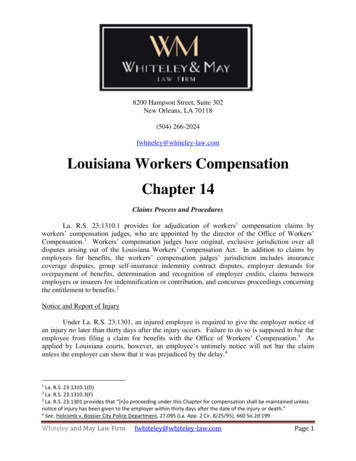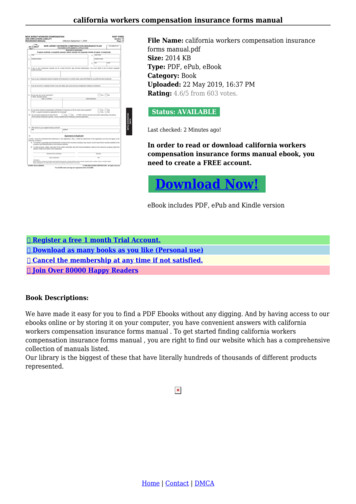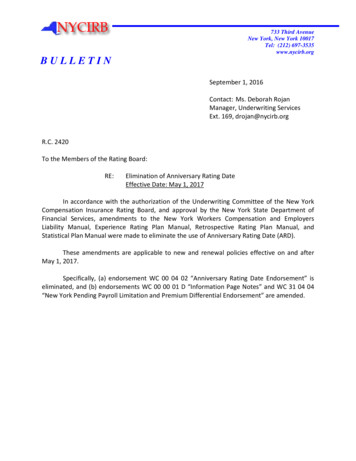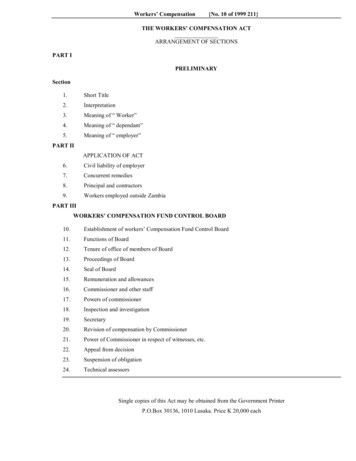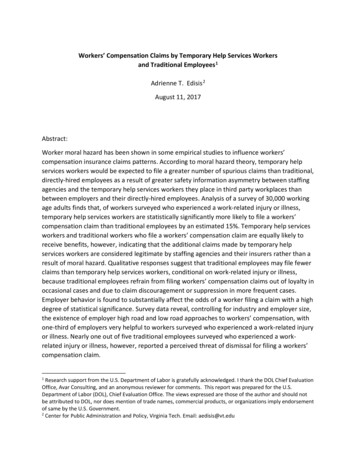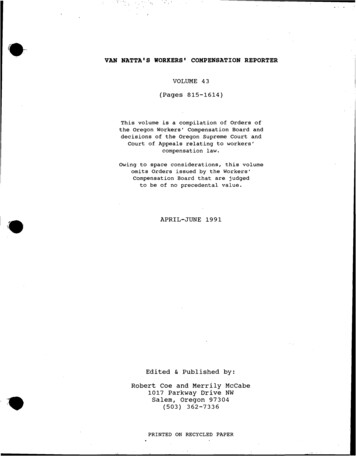
Transcription
,.'.VAN NATTA'S WORKERS' COMPENSATION REPORTERVOLUME 43(Pages 815-1614)This volume is a compilation of Orders ofthe Oregon Workers' Compensation Board anddecisions of the Oregon Supreme Court andCourt of Appeals relating to workers'compensation law.Owing to space considerations, this volumeomits Orders issued by the Workers'Compensation Board that are judgedto be of no precedental value.APRIL-JUNE 1991Edited & Published by:Robert Coe and Merrily McCabe1017 Parkway Drive NWSalem, Oregon 97304(503)362-7336PRINTED ON RECYCLED PAPER
CONTENTSPageWorkers' Compensation Board Orders . . . . . . . . . . . 815 -List of Court Decisions . . . . . . . . . . . . . . . . . . . . . . 1531Subject Index . . . . . . . . . . . . . . . . . . . . . . . . . . . . . . . . 1536Ci tat ions to Court Cases . . . . . . . . . . . . . . . . . . . . . 1565References to Van Natta's Cases . . . . . . . . . . . . . . 1576ORS Citations . . . . . . . . . . . . . . . . . . . . . . . . . . . . . . . . 1587Administrative Rule Citations . . . . . . . . . . . . . . . . 1594Larson Citations . . . . . . . . . . . . . . . . . . . . . . . . . . . . . 1602Oregon Rules of Civil Procedure Citations . 1602Oregon Evidence Code Citations . . . . . . . . . . . . . . . 1602Claimant Index . . . . . . . . . . . . . . . . . . . . . . . . . . . . . . . 1603CITE AS43 Van Natta(1990)
March 27, 1991Cite as 43 Van Natta 815 (1991)815In the Matter of the Compensation ofLANNY L, MILLS, ClaimantWCB Case No. 90-11034ORDER ON REVIEWDes Connall, Claimant AttorneyGordon L. Welborn, Defense AttorneyReviewed by Board Members Brittingham and N1chols.The insurer requests review of Referee Leahy's order which increasedclaimant's scheduled permanent disability award for loss of use or function ofthe right arm from 5 percent (9.6 degrees), as awarded by Determination Order,to 30 percent (57.6 degrees). On review, the issue is extent of scheduled per manent partial disability. We modify.FINDINGS OF FACTWe adopt the Referee's "Findings of Fact" and supplement with the· follow ing findings.Prior to surgery, Dr. Kramer, claimant's former treating osteo pathic physician, restricted claimant to lifting 35 pounds with his right armand prescribed a tennis elbow splint.Claimant's current treating physician, orthopedic surgeon Baum, performeda right lateral epicondylar release. This surgery did not improve claimant'scondition. Dr. Baum notes that'claimant continues to require wrist and elbowbracing, and has advised claimant to avoid heavy lifting.Claimant continues to experience discomfort performing his regular jobduties. He cannot lift at work without wearing wrist/arm braces.FINDING OF ULTIMATE FACTClaimant has sustained a 10 percent loss of use or function of his rightarm as a result of his compensable elbow injury.CONCLUSIONS OF LAW AND OPINIONFinding clear and convincing evidence of impairment greater than that con templated under the standards, the Referee increased cla1mant's scheduled perma nent disability award from 5 percent to 30 percent. The insurer argues thatclaimant failed to meet the clear and convincing standard of evidence and,therefore, contends that claimant's disability should be rated under the"standards." Nevertheless, the insurer indicates that claimant is entitled to a5 percent disability award based on a surgical procedure not specified in thestandards.For purposes of determining injury-related permanent partial disability,former ORS 656.283(7) and 656.295(5) require application of the standards forthe evaluation of disabilities adopted by the Director pursuant to ORS656.726(3)(f)(A). Those "standards" in effect on the date of the DeterminationOrder from which the hearing was requested control the evaluation of permanentpartial disability. OAR 438-10-010(1).Because claimant became medically stationary on March 1, 1990 and hisclaim was closed by Determination Order on April 13, 1990, the "standards" ineffect January 1, 1989 are used in rating claimant's permanent disability.For mer OAR 436-35-001 et seq. Former OAR 436-35-010 through 436-35-260 apply tothe ratingclaimant's scheduled permanent disability.Former OAR 436-35010(1).of
816Lanny L Mills, 43 Van Natta 815 (1991)Disability Under the StandardsIn his March 1, 1990 closing examination, Dr. Baum reported that claimanthas mild permanent impairment consisting primarily of right arm pain with repet itive use. The doctor noted that claimant has no loss of range of motion, nomuscle weakness, no sensory loss, and no atrophy. Although claimant has under gone a right lateral epicondylar release, that surgical procedure is not coveredby the standards. Former OAR 436-35-110(4)(a) through OAR 436-35-110(4){k).Thus, there is no basis to award claimant a 5 percent impairment value for hiselbow surgery as the insurer suggests. Accordingly, other than a chronic condi tion limiting repetitive use, claimant has no rateable elbow/arm impairment forwhich a value may be assigned under the "standards." See former OAR 436-35100(1) through OAR 436-35-100(8) and former OAR 436-35-110(3).Claimant is entitled to an award of 5 percent for loss of repetitive useFormer OAR 436-35-010(7). Claimant"s total impairment underof the right arm.the standards is, therefore, 5 percent.Disability Outside the StandardsEither party may establish that the record as a whole constitutes clearand convincing evidence that the degree of permanent partial disability sufferedby claimant is more or less than the entitlement indicated by the "standards."Former ORS 656.283(7) and 656.295(5). To be clear and convincing, evidence mustestablish that the truth of the asserted fact is "highly probable," free fromconfusion, fully intelligible and distinct. Riley Hill General Contractor, Inc .Y.!. Tandy Corp., 303 Or 390, 402 (1987) .On review, claimant urges the Board to affirm the Referee"s award of 30percent scheduled permanent disability. We agree that claimant is entitled to agreater impairment value than that awarded under the standards. Dr. Kramer ini tially restricted claimant to lifting 35 pounds with his right arm and pre scribed a tennis elbow splint. Although claimant later underwent a right lat eral epicondylar release, this procedure did not improve claimant's condition.Thereafter, Dr. Baum also advised claimant to avoid heavy lifting.The record as a whole clearly establishes that claimant continues to re quire wrist and elbow bracing in order to perform his at-injury job. Claimant'sright elbow condition is disabling and results in loss of use or function beyondthe 5 percent indicated by the standards. We, therefore, conclude that claimanthas shown by clear and convincing evidence that he suffers scheduled permanentdLsability of 10 percent due to his right epicondylitis with unsuccessful lat eral epicondylar release.The Referee"s order dated September 24, 1990 is modified.In lieu of theReferee's award and in addition to the 5 perce t (9.6 degrees) scheduled perma nent disability awarded by the Determination Order, claimant is awarded5 percent (9.6 degrees) scheduled permanent disability, giving him a total awardto date of 10 percent (19.2 degrees) scheduled permanent disability for loss ofuse or function of the right arm. Claimant's attorney fee shall be adjustedaccordingly.
April 1, 1991Cite as 43 Van Natta 817 (1991)817In the Matter of the Compensation ofDAVID A. STEINER, ClaimantWCB Case No. TP-91002THIRD PARTY DISTRIBUTION ORDERPozzi, et al., Claimant AttorneysMichael o. Whitty (Saif), Defense AttorneyThe SAIF Corporation, as a paying agency, has petitioned the Board to re solve a dispute concerning the amount of SAIF's lien for its expenditures forcompensation under ORS 656.593(l)(c) it may recover from a third party judgment.ORS 656.593(l)(d). Specifically, the dispute pertains to whether SAIF's lienincludes an attorney fee paid out of the increased permanent disability compen sation awarded by a Referee order. We conclude that attorney fees payable outof claimant's permanent disability award are compensation and, as such, SAIF isentitled to reimbursement for such claim costs as part of its third party lien.FINDINGS OF FACTIn July 1984, while working as an installer, claimant sustained a compens able injury to his feet when he fell 20 feet and landed on his heels. He suf fered closed fractures to both feet, which were subsequently casted.In Septem ber 1984 claimant returned to work performing light duty work as an estimator.Because of persistent pain complaints, his ability to walk, stand, squat, stoop,or drive a vehicle has been significantly altered.In February 1985, his claim was closed by Determination Order. Claimantwas awarded 30 percent scheduled permanent disability for loss of use or func tion of the left foot and 25 percent for loss of use or function of the rightfoot.Claimant requested a hearing, which resulted in a November 1985 Referee'sorder.Claimant's awards were increased to 75 percent scheduled permanent dis ability for the left foot and 65 percent for the right foot.Claimant's attor ney was awarded an attorney fee payable out of the increased compensationgranted by the Referee's order. The attorney fee equaled 25 percent of theincreased compensation, not to exceed 2,000.Claimant retained legal counsel to pursue a third party action for damagesarising from his compensable injury. A civil action was instituted, which even tually resulted in a judgment against the third party for negligence totalling 383,585.75.SAIF notified claimant of its third party lien, asserting that it hadincurred claim costs totalling 30,706.46. SAIF's lien included those portionsof the permanent disability awards payable to claimant as well as the 2,000attorney fee.Shortly after the third party judgment bec me final, claimant's counselforwarded to SAIF 28,706.46. This sum represented SAIF's current lien, lessthe 2,000 attorney fee.SAIF accepted the payment as a partial payment, butcontinued to seek reimbursement of the disputed attorney fee.Noting that itsthird party lien for claim costs was actually 30,465.92, SAIF requested 1,759.46 as full reimbursement.-CONCLUSIONS OF LAWThe statutory formula for the allocation of damages from a third partyjudgment under ORS 656.593(1) is precise. Robert B. Williams, 38 Van Natta 119,123 (1986), aff'd Estate of Troy Vance v. Williams, 84 Or App 616, 619-20(1987). Attorney fees and costs incurred, in pursuit of the third party recovery
818David A. Steiner, 43 Van Natta 817 {1991)shall be initially disbursed. Then the worker shall receive at least 33-1/3percent of the balance of the recovery. ORS 656.593(1)(b) The paying agency shall be paid and retain the balance of the recovery tothe extent that it is compensated for its expenditures for compensation, firstaid or other medical, surgical or hospital service, and for the present value ofits reasonably to be expected future expenditures for compensation and othercosts of the worker's claim under ORS 656.001 to 656.794. ORS 656.593(l)(c).Such other costs include assessments for reserves in the Insurance and FinanceFund, but do not include any compensation which may become payable under ORS656.273 or 656.278.Id. Any remaining balance shall be paid to the worker.ORS 656.593(l)(d).Finally, any conflict as to the amount of the balance whichmay be retained by the paying agency shall be resolved by the Board.Id.Here, the dispute centers on whether the attorney fee awarded by theReferee's order to be paid out of claimant's increased permanent disabilityaward is compensation for purposes of ORS 656.593(l)(c). We conclude that suchan attorney fee is compensation and, thus, is reimbursable as a claim cost froma third party recovery. Our conclusion is based on the following reasoning."Compensation" includes all benefits, including medical services, providedfor a compensable injury to a subject worker the worker's beneficiaries by aninsurer or self-insured employer pursuant to ORS Chapter 656. ORS 656.005(8) .Attorney fees a claimant recovers against an insurer after prevailing against adenial of a claim are not recoverable by the insurer as an "other cost" of theclaim under ORS 656.593(1)(c). Schlecht v. SAIF, 60 Or App 449, 457 (1982).However, attorney fees which are payable out of claimant's compensation retaintheir identity as compensation. SAIF v. Gatti, 72 Or App 106 (1985); Candy J.Hess, 37 Van Natta 12, 13 (1985); Robert G. Perkins, 36 Van Natta 1050, 1051(1984).Claimant argues that the third party statutes never intended to permit apaying agency to recover as part of its lien an attorney fee payable out of asucessfully appealed Determination Order.Instead, claimant submits that thepaying agency's lien should be limited to those claim costs paid to the worker.We disagree with claimant's contention. ORS 656.593(l)(c) expressly ex cludes a paying agency from recovering expenditures for compensation payableunder ORS 656.273 and 656.278. Considering such an expressed intention, had thelegislature further intended to prohibit a paying agency from recovering asclaim costs attorney fees which it had been required to pay out of claimant'sc mpensation, we believe that the statute would have so provided.Furthermore,since the issue presented for our resolution concerns whether the attorney feeallowed from claimant's permanent disability award is compensation rather thanan insurer-paid attorney fee as an "other cost" of the claim, the Schlecht hold ing has no application. Lacking neither a legislative directive nor an applica ble court holding, we continue to adhere to our prior decisions which supportthe proposition that attorney fees payable out of compensation retain theiridentity as compensation under Chapter 656. Because such ·fees are compensation,they are reimbursable from claimant's third party recovery under ORS656.593(1) (C).In reaching this conclusion, we wish to emphasize that all of the perma nent disability compensation granted by the Referee's order was awarded toclaimant. Yet, in accordance with the Board's attorney fee rules (then OAR 438Division 47; now OAR 438 Division 15), and ORS 656.386(2), a portion of thiscompensation was paid directly to his attorney'. Thus, we are not persuaded byclaimant's attempt -to characterize the attorney fee as never part of his compen sation.-
David A. Steiner, 43 Van Natta 817 (1991)819Accordingly, claimant's counsel is directed to forward 1,759 .46 to SAIFwhich shall constitute its entire share of the third party recovery. ORS656.593(1)(c), (d).IT IS SO ORDERED.April 2, 1991Cite as 43 Van Natta 819 (1991)In the Matter of the Compensation ofJOHN W. KUYKENDALL, ClaimantWCB Case No. TP-90056THIRD PARTY ORDER ON RECONSIDERATIONSmith & Smith, Claimant AttorneysJ. David Thurber (Saif), Defense Attorney-On March 21, 1991, we abated our March 8, 1991 Third Party DistributionOrder, which had held that the SAIF Corporation was entitled to 33,167.50 ofthe 37,248.53 balance remaining from a third party recovery. We took this ac tion to consider claimant's motion that we modify our order to find that thethird party recovery was by means of judgment rather than by settlement and todirect SAIF rather than claimant's counsel to provide claimant with the 4,081.03 balance remaining from the recovery after distribution of its share ofthe proceeds. Having received SAIF's .response, we proceed with our reconsidera tion.Upon further review, we find that the third party recovery was realizedthrough a judgment and not by settlement as stated in our prior order. There fore, our order is amended to reflect this modification.In addition, sinceSAIF has been in possession of the 37,248.53 remaining balance of proceeds fromthe third party judgment and because we have found that it is entitled to re cover 33,167.50 as its share of the recovery, SAIF rather than claimant's coun sel is directed to pay the remaining 4,081.03 to claimant under ORS656.593(1)(d).Based on SAIF's response, this action has already apparentlybeen taken.Accordingly, as supplemented and modified herein, we adhere to and repub lish our March 8, 1991 order. The parties' rights of appeal shall run from thedate of this order.IT IS SO ORDERED.April 3, 1991Cite as 43 Van Natta 819 (1991)In the Matter of the Compensation ofEVELYN CHRISTENSON, ClaimantWCB Case No. Cl-00240ORDER DISAPPROVING CLAIM DISPOSITION AGREEMENTWhitehead & Klosterman, Claimant AttorneysNelson, et al., Defense AttorneysOn March 12, 1991, the Board received the parties' claim dispositionagreement in the above-captioned matter. Pursuant to that agreement, in consid eration of the payment of 25,000 by Liberty Northwest Insurance Corporation,claimant releases certain rights to future workers' compensation benefits, ex cept medical services, for the compensable injury.In a release signed in con junction with the claim disposition agreement, claimant agrees to release herright to reemployment and claims for unemployment compensation benefits with theemployer. We set aside the proposed disposition.
820Evelyn Christenson, 43 Van Natta 819 (1991)ORS 656.236(1) permits parties, by agreement, to make "such disposition ofany or all matters regarding a claim, except for medical services, as the par ties consider reasonable," subject to the terms and conditions prescribed by theDirector. The Director's rules define a "claim disposition agreement" as awritten agreement in which a "claimant agrees to release rights, or agrees torelease an insurer or self-insured employer from obligations, under ORS 656.001to 656.794 except for medical services, in an accepted claim. OAR 436-60005(9). See also OAR 438-09-001(1). The underscored portion of the ·rule makesclear that only rights and/or obligations under ORS Chapter 656 may be releasedby a claim disposition agreement.Here, the proposed disposition releases rights and obligations under ORSChapter 656, but also purports to release cl imant's right to reemployment underORS Chapter 659, and to unemployment claims under ORS Chapter 657.See ORS659.415; ORS 657.155. The release of the right to reemployment and unemploymentbenefits, because they concern matters outside of ORS Chapter 656, are notproper matters for disposition under ORS 656.236 and the rules promulgatedthereunder.Karen Vearrier, 42 Van Natta 2071 (1990).Indeed, there is noauthority which permits us to approve a release of reemployment rights.Forthose reasons, the proposed disposition is not a "claim disposition Sgreement"as defined by OAR 438-09-001(1). Accordingly, we are without authority toapprove any portion of the proposed disposition.We are aware that the parties have attempted to ·establish a separation be tween the release of rights under ORS 656 and ORS 659. However, the releasespecifically states that the consideration for release of rights under ORS 656also constitues consideration for release of rights under ORS 659.It is clearthat we are dealing with a single bargain. Therefore, the documents areinseparable.Inasmuch as the proposed disposition has been disapproved, the insurer orself-insured employer shall recommence payment of temporary or permanent dis ability that was stayed by submission of the proposed disposition. OAR 436-60150 ( 4) ( i) and ( 6) ( e) .-Following our standard acknowledgment procedures, we would be willing toconsider a revised agreement which does not contain provisions exceeding ourauthority under ORS 656.236 and OAR 438-09.IT IS SO ORDERED.April 3 , 19 91Cite as 43 Van Natta 820 (1991)In the Matter of the Compensation ofRONALD E. GONSHOROWSKI, ClaimantWCB Case No. 90-12633ORDER OF DISMISSALConnall & Lorenz, Claimant AttorneysJerome P. Larkin (Saif), Defense AttorneyThe SAIF Corporation has moved the Board for an order dismissingclaimant's request for review on the ground that the request was not timelyfiled.The motion is granted.FINDINGS OF FACTThe Referee's order. issued November 13, .1990. The order included noticeof when (within 30 days) and where (with the Workers' Compensation Board) arequest for review of the order should be filed.On December 18, 1990, the-
Ronald E. Gonshorowski, 43 Van Natta 820 (1991)-821Board received a letter from SAIF. SAIF's letter enclosed a letter fromclaimant expressing dissatisfaction with the Referee's November 13, 1990 order.Claimant's letter was dated December 11, 1990, postmarked on December 12, 1990,and addressed to SAIF's trial counsel. SAIF's date stamp indicates receipt of.claimant's letter on December 13, 1990.The Board's computer-generated letter acknowledging the request was mailedon December 20, 1990.ULTIMATE FINDINGSClaimant's request for review was not received by the Board within 30 daysof the Referee's order.CONCLUSIONS OF LAWA Referee's order is final unless, within 30 days after the date on whicha copy of the order is mailed to the parties, one of the parties requests Boardreview under ORS 656.295. ORS 656.298(3).' Requests for Board review shall bemailed to the Board and copies of the request shall be mailed to all parties tothe proceeding before the Referee.· ORS 656.295(2). Compliance with ORS 656.295requires that statutory notice of the request for review be mailed or actualnotice be received within the statutory period. Argonaut Insurance Co. v. King,63 Or App 847, 852 (1983).-·Here, the 30th day after the Referee's November 13, 1990 order was Decem ber 13, 1990. Assuming that claimant's letter to SAIF's counser constituted arequest for Board review of the Referee's order, the request was received bySAIF on December 13, 1990, 30 days from the Referee's order.However, therecord fails to establish that the request was mailed to, or received by, theBoard within the statutory 30-day period. Consequently, we lack authority toreview the order which has become final by operation of law.See ORS656.289(3); 656.295(2); Argonaut Insurance Co. v. King, supra; Robert G. Ebbert,40 Van Natta 67 (1988).We are mindful that claimant has apparently requested review without bene fit of legal representation. We further realize that an unrepresented party isnot expected to be familiar with administrative and procedural requirements ofthe Workers' Compensation Law. However, instructions for requesting review wereclearly stated in the Referee's order. Moreover, we are not free to relax ajurisdictional requirement, particularly in view of Argonaut Insurance Co. v.King, supra. See Alfred F. Puglisi, 39 Van Natta 310 (1987); Julio P. Lopez, 38Van Natta 862 (1986).Accordingly, the request for Board review is dismissed.April 3, 1991Cite as 43 Van Natta 821 (19911In the Matter of the Compensation ofCAROL D. GOSS, ClaimantWCB Case No. 89-10994ORDER ON REVIEWGarlock & Smith, Claimant AttorneysTerrall & Miller, Defense AttorneysReviewed by Board Members Myers, Cushing and Crider.The self-insured employer requests review of Referee Shebley's order that:(1) declined to apply the doctrine of res judicata as a bar to claimant's claimfor a low back and left hip condition; and (2) on the merits, set aside its
822partial denial of the claim.compensability. We reverse.Carol D. Goss, 43 Van Natta 821 (1991)On review, the issues are res judicata andFINDINGS OF FACTOn October 6, 1987, claimant compensably injured her right foot causingright foot, ankle and knee pain.In August 1988 claimant returned to work.Herfoot later swelled and hurt.-A September 9, 1988 Determination Order awarded claimant 4 percent perma nent disability for her ight leg (knee) injury.In November 1988, claimant's treating chiropractor, Dr. Phillips, tookclaimant off work because of left hip and low back pain. According to Phillipsthe left hip and low back pain was caused by placing extra weight on the leftleg because of the accepted right ankle injury.On December 9, 1988, the employer denied an aggravation claim, on thebasis that "your condition has not worsened since your claim was previouslyclosed."(Ex. 26-1). The denial was not challenged and became final byoperation of law.Claimant continued to treat with Dr. Phillips for identical low back andleft hip conditions.on May 16, 1989 the employer issued a partial denial, of claimant's cur rent low back and left hip conditions on the basis that they were unrelated tothe compensable right foot injury.(Ex. 44-1). Claimant appealed this denial.ULTIMATE FINDINGS OF FACTThere was no change in claimant's condition or treatment during the inter val between the December 1988 aggravation denial and the May 1989 partialdenial.CONCLUSIONS OF LAW AND OPINION·-The Referee found that the issues raised by the December 1988 aggravationdenial were different from those raised by the May 1989 partial denial. Wedisagree."Preclusion by former adjudication," generally referred to as resjudicata, is a "doctrine of rules and principles governing the binding effect ona,subsequent proceeding of a final judgment previously entered in a claim."Drews v. EBI Companies, 310 Or 134 (1990). Preclusion by former adjudicationincludes "issue preclusion" and "claim preclusion".,Issue preclusion acts as a bar only when:(1) the same parties (2) actu ally litigate an issue of law or fact (3) which is necessary to (4) a valid andfinal judgment. Jimmy M. Campoz, 42 Van Natta 903 (1990).Because the Decemberdenial was not actually litigated to judgment, issue preclusion does not apply."Claim preclusion" precludes a plaintiff who has prosecuted one actionagainst a defendant through to a final judgment from prosecuting another actionagainst the same defendant where the claim in the second action is one based onthe same factual transaction that was at issue in the first, and where theplaintiff seeks a remedy additional or alternative to the one sought in thefirst, and is of such a nature as could have been joined in the first action.Drews, supra at 140, citing Rennie v. Freeway Transport, 294 Or 319, 323 (1982).Claim preclusion does not require actual litigation. Where, as here, the Decem ber 1988 denial became final because claimant chose, not to request a hearing,-
carol D. Goss, 43 Van Natta 821 (1991)823she may not litigate the same claim or claims which arise from the same transac tion or series of transactions. We conclude that the effect of the December1988 denial was to finally determine that claimant's left hip and.low back con ditions were not compensable. Thus, the question is whether claimant's condi tion has changed so as to create a new set of operative facts that previouslycould not have been litigated.Thus, claimant must show that her current low back and left hip conditionis changed from her condition at the time of the December 1988 aggravation de nial, which became final by operation of law. See Proctor v. SAIF, 68 Or App333 (1984); Irene Jenson, 42 Van Natta 2838 (1990). Claimant's present claimfor her low back and left hip condition is merely a different characterizationof the identical conditions which led to the 1988 aggravation denial. 1Claimant's treating chiropractor, Dr. Phillips, provided the same treatment forclaimant's low back and left hip from November 1988 through July 1989. More over, Dr. Phillips' diagnosis regarding the left hip and low back conditionsremained the same throughout this period.Finally, there were no conditions present at the time of the May 1989denial, that did not already exist when the December 1988 aggravation denial wasissued.The fact that claimant now asserts her claim by another legal theorydoes not alter the preclusive effect of the denial, hich became final throughoperation of law. Million v. SAIF, 45 Or App 1097, 1102 rev den 289 Or 337(1980) (Res Judicata applies not only to every claim included in the pleadings,but every claim which could have been alleged under the same aggregate of opera tive facts).Accordingly, we find that under the doctrine of claim preclusion, claimantis barred from litigating the compensability of her present low back and lefthip condition.Because we have determined that claimant is precluded .from liti gating the merits of her current condition, we need not address compensability.The Referee's order dated March 5, 1990 is reversed.The insur-er's denialis reinstated and upheld. The Referee's assessed attorney fee award of 2,257.50 is reversed.I The dissent recognizes that the Restatement of Judgments 2d instructs us todetermine pragmatically what constitutes a single transaction for purposes ofclaim preclusion.It then ignores that instruction. The dissent's characteri zation of the majority opinion is that we are saying that every time an aggrava tion denial is let stand, then there is a preclusive effect both on the questionof a worsening and on the question of current medical services.On the contrary, we are saying that under the facts of this particularcase, the denial was not only a denial of a worsening, but was a denial ofclaimant's current condition because what had been claimed was that the aggrava tion was based on new conditions.In other words, we have viewed this casepragmatically and determined that the operative facts for purposes of claimpreclusion are what was claimed and are not restricted to the narrow wording ofthe denial.Board Member Crider, dissenting.The panel's application of the doctrine of claim preclusion in this caseis wrong.It is unfair to this claimant. Moreover, it will have the effect,not of minimizing litigation, but instead of forcing parties to undertake liti gation of denials to which they do not object in order to preserve rights in a
824Carol D. Goss, 43 Van Natta 821 (1991)compensable claim which have not beeri actually denied.If accepted principlesof res judicata required this result, we would be compelled to accept this un fortunate result.Because I do not believe that the law compels this result, Idissent.L.In this case, claimant allowed a denial of aggravation.tb stand withoutchallenge.She requested a hearing on a later denial of compensability of par ticular conditions. The panel holds that she is not entitled to a hearing onthe se
VAN NATTA'S WORKERS' COMPENSATION REPORTER VOLUME 4 3 (Pages 815-1614) This volume is a compilation of Orders of the Oregon Workers' Compensation Board and decisions of the Oregon Supreme Court and Court of Appeals relating to workers' . scribed a tennis elbow splint. Although claimant later underwent a right lat

